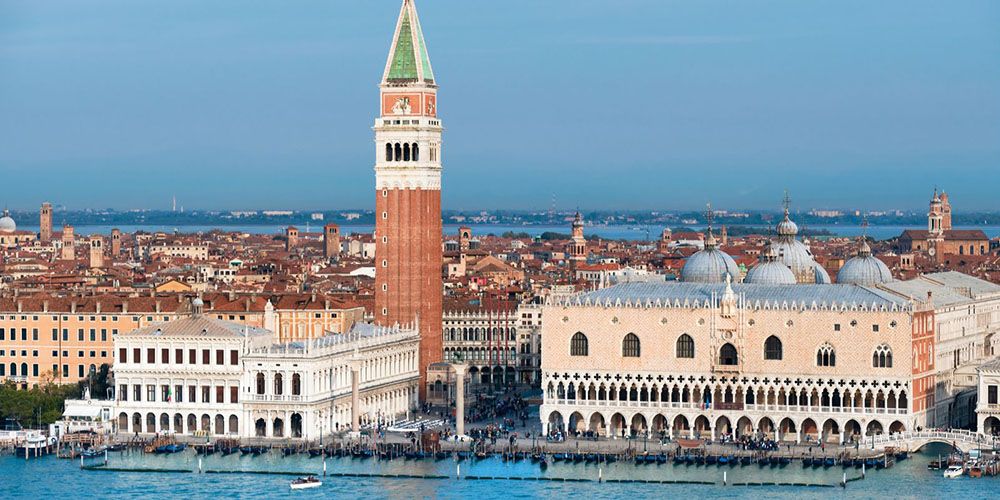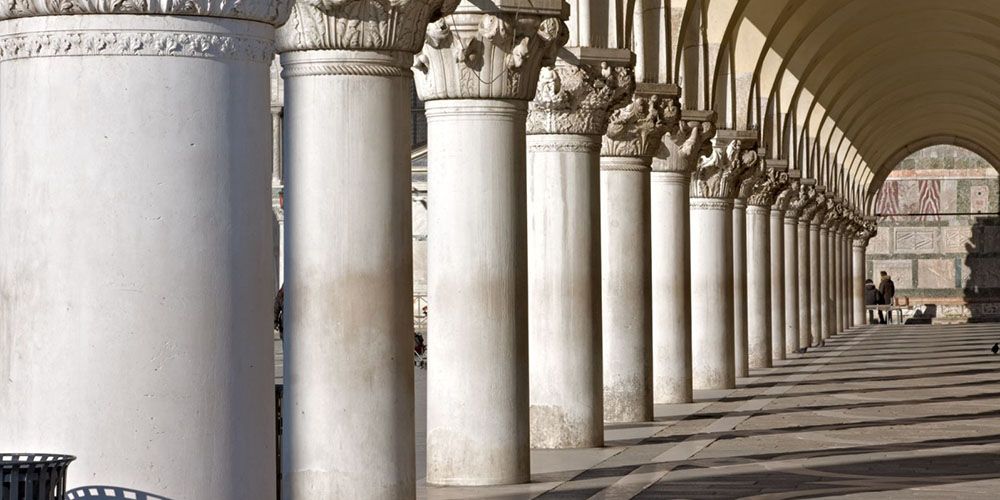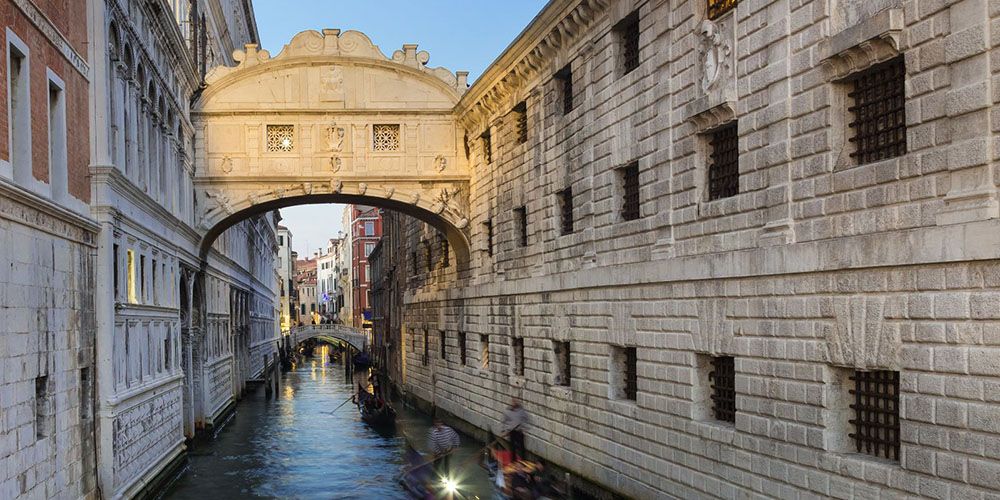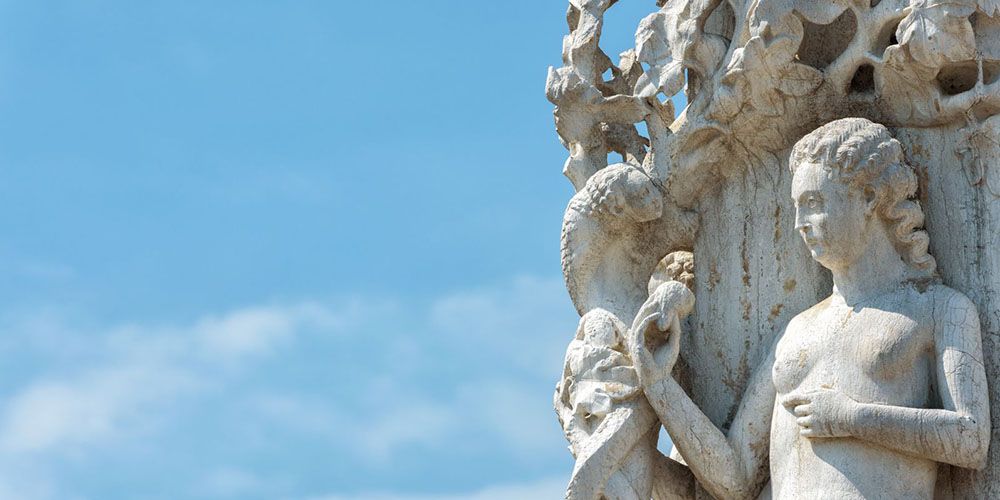Located in the San Marco district, a few steps from the famous Basilica of San Marco, the Doge's Palace is one of the symbols of the city of Venice. A masterpiece of Venetian Gothic art, it is also known as Dogal Palace, for having been the seat of the doge's apartments. Its foundation dates to 810, following the move of the seat of government from the island of Malamocco to the Rialto area.
Originally, Palazzo Ducale appeared as a fortified structure, with a tower in each corner. Over the centuries, renovations and expansions have been carried out, modifying the original plan. When the Republic of Venice fell, the Doge's Palace lost its governmental function and first became the Marciana National Library, then the Opera Museum and finally the Civic Museum, part of the MUVE Foundation (Civic Museums of Venice). For your visit to Venice, we suggest you consider the Venice Pass, a single card that includes access to the major attractions of Venice, including the Doge's Palace and offers the possibility of having discounts in restaurants, hotels and shops and much more.
Doge’s Palace: the architectural structure

The architectural structure of Doge’s Palace is very complex. To visit it is useful to know that inside you will find three large areas: the Sala del Maggior Consiglio towards the San Marco basin which represents the oldest wing, the Palace of Justice and the Sala dello Scrutinio towards Piazza San Marco and finally the Renaissance wing with the Doge's residence.
These were followed in the second half of the 16th century by the construction of the new prisons and the Bridge of Sighs; the famous master of seduction Giacomo Casanova was also locked up in these feared prisons. Over the years the palace has been the protagonist of several fires and subsequent rebuilding which have modified its structure, in fact its current appearance dates back only to 1577, the year in which the fire occurred in the Sala dello Scrutinio and in the Sala del Maggior Consiglio.
Guide to visiting the Doge's Palace

The visit to the Doge's Palace begins from the Porta del Frumento, located in the south wing, the oldest of the palace, facing the San Marco basin. From here you will be accompanied directly to the courtyard which offers a view of the porticoes and loggias. It is precisely at this point that you begin to perceive the variety of styles that make up Doge’s Palace, observe the southern and western internal facades which present a Venetian Gothic appearance, while the eastern facade is characterized by a Renaissance style decoration. From the courtyard you will be able to access the loggias on the first floor via the Scala dei Giganti, named after the two marble statues of Mars and Neptune placed on its sides, which were supposed to represent the power of Venice on the sea and on land. The imposing staircase is also remembered for being the place where ducal coronations took place.
At the top of the Scala dei Giganti you will find the Piano delle Logge, here it is possible to wander along the three wings of the palace: east, south and west with views overlooking Piazza San Marco and the courtyard. The loggias give the palace an extraordinary feeling of lightness. In addition to the loggias on this floor there is another architectural wonder, the Golden Staircase, which owes its name to the decorations in pure gold leaf and white stucco of the vault, created starting from 1557 by Alessandro Vittoria.
Once you reach the first noble floor via the Golden Staircase you will find both the Ducal Apartment and the Sala del Maggior Consiglio. In these rooms you will not find the original furniture because the Doges of Venice had to provide the furniture independently and consequently, once the Doge died, the furniture became the property of the heirs and was taken away. However, you will be able to admire the pictorial decorations, some of which were created by Pietro Lombardo.
The Sala del Maggior Consiglio, on the other hand, was the seat of the highest Venetian judiciary which had the task of electing all the major state offices and legislating for the community. It is considered one of the largest in Europe thanks to its enormous dimensions: 53.50 meters long and 15.40 meters high, it has no support columns because the structural stability of the ceiling is achieved thanks to a system of trusses above magnificent pictorial and coffered decoration in gilded wood. When you enter this room, observe the background pictorial decoration: it is Il Paradiso, a work by Jacopo Tintoretto dating back to the end of the sixteenth century. Its extension of 22 meters in length and seven and a half meters in height makes it the largest canvas in the world. The visit to the Doge's Palace ends with the exit from the Porta della Carta which is thought to take its name from the habit of posting laws and decrees there or from the presence of public scribes and archives of state documents.
A stay just a few steps from the Doge’s Palace

Staying in the center of Venice is always a dream, having the opportunity to sleep a few steps from the iconic places of the Lagoon offers the opportunity to fully enjoy their rare beauty. You will have the chance to feel like a local, even if for a short time. Venice offers a lot of choice in terms of accommodation, you will be able to find the solution most in line with what you are looking for, from cheap hotels to luxury ones. Staying in the historic center on a logistical level offers you the opportunity to rest during the day, without getting lost in the labyrinthine Venetian streets to find your hotel.
We suggest the Hotel Antigo Trovatore, some rooms of this hotel have access to a private terrace, from which you can enjoy a splendid view of the sixteenth-century façade of Palazzo Ducale and the Campanile of San Marco. Having breakfast while looking at Venice from above is a real emotion. The hotel is in Calle delle Rasse, a name that derives from the production of rough wool blankets used for gondola cabins, the famous felze. The nearest vaporetto (Venice public water transport) stop is San Zaccaria. As an alternative to public transport, you can opt for the private taxi service, or why not, find the opportunity to treat yourself to a gondola ride back.
Doge's Palace in Venice: timetables and tickets

The Doge's Palace in Venice is open every day, following summer opening hours (from 1st April to 31st October) from 9.00 to 19.00 and winter opening hours (from 1st November to 31st March) from 9.00 to 6.00pm. We would like to inform you that from May 1st to September 30th, 2024, every Friday and Saturday you will have the opportunity to visit the museum even in the evening, until 11.00 pm.
As regards tickets, there is the opportunity to purchase a single ticket valid for all the museums in Piazza San Marco (Doge's Palace, Correr Museum, National Archaeological Museum and Marciana Library) at a cost of 25 euros. We once again recommend the Venice Pass which includes access to the main attractions of Venice, including the Doge's Palace, the Peggy Guggenheim collection and many discounts and benefits in restaurants, shops, hotels and events.










Lascia un commento